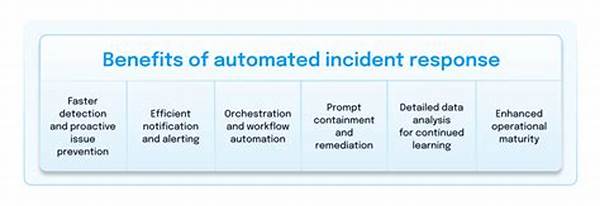Hey there, cyber aficionados! Today, we’re diving into a topic that’s all the rage in the cybersecurity world—automated incident response systems. If you’re like me and love learning about how tech can solve pesky problems, you’re in for a treat. Think of these systems as your high-tech, 24/7 security guards, tirelessly working to keep your digital assets safe while you binge-watch your favorite series on Netflix. Intrigued? Let’s get into it!
Understanding Automated Incident Response Systems
So, what are automated incident response systems, you ask? Imagine having a superhero team always on standby, ready to swoop in and save the day the moment something suspicious occurs. That’s pretty much what these systems do, but for your cyber environment. They automatically detect threats, analyze them, and respond instantly—often faster than humans could.
Now, while the idea of machines handling cybersecurity might sound straight out of a sci-fi movie, it’s becoming common practice in many industries. Automated incident response systems are all about speed and efficiency. They can process vast amounts of data quickly, identifying signs of trouble that might take a human analyst hours or even days to spot. So, they’re like the Flash of cybersecurity—super-fast and pretty cool!
What makes automated incident response systems even more impressive is that they can learn and adapt. Thanks to machine learning algorithms, they get smarter over time, improving their ability to distinguish between harmless anomalies and genuine threats. Plus, having these systems in place frees up your IT team to focus on strategic tasks instead of constantly firefighting.
The Benefits of Automated Incident Response Systems
1. Speedy Detection and Response
Automated incident response systems excel in quick threat detection, ensuring almost instantaneous action once a threat is identified.
2. Reduced Human Error
These systems mitigate human error by automating the complex, repetitive tasks involved in cybersecurity.
3. 24/7 Protection
You can count on automated incident response systems to continually monitor and respond to threats, day and night.
4. Scalability
As your organization grows, so can your response capabilities, making these systems ideal for scaling operations securely.
5. Cost-Effective
Over time, automated incident response systems can be more cost-effective than maintaining an ever-expanding team of human analysts.
Challenges with Automated Incident Response Systems
But it’s not all sunshine and rainbows. Automated incident response systems do have their challenges. For instance, they require significant initial setup and fine-tuning to avoid false positives—alerting on non-issues can be more disruptive than helpful. And while these systems are getting smarter, they’re not yet perfect.
Another challenge is integration. Getting your shiny new automated incident response system to play nice with your existing IT infrastructure can be a bit of a dance. However, once ironed out, the benefits really shine through, allowing your IT team to strategize and innovate rather than being buried under alerts.
Lastly, some folks worry about AI taking over jobs. While it’s true that automated incident response systems reduce the need for manual monitoring, they don’t replace the need for skilled cybersecurity professionals. Instead, they enhance their capabilities, enabling them to focus on advanced threat analysis and developing robust security strategies.
Real-World Applications of Automated Incident Response Systems
In real-world applications, automated incident response systems are proving to be game-changers. From large enterprises to small businesses, organizations are implementing these systems to safeguard sensitive data. Whether it’s banking, healthcare, or retail, the need for efficient incident response has never been greater.
Moreover, industries that deal with enormous amounts of data are especially benefiting. Think of healthcare facilities—where patient data is crucial—or financial institutions handling millions of transactions. Automated incident response systems can sift through this mountain of information, identifying irregularities promptly.
By utilizing automated incident response systems, companies not only protect themselves from cyber threats but also gain customer trust. In a world where data breaches can shatter reputations overnight, having a robust incident response plan is indispensable.
The Future of Automated Incident Response Systems
Looking ahead, the future is bright for automated incident response systems. As artificial intelligence and machine learning technologies advance, these systems are set to become even more intelligent and intuitive. They’ll likely offer more personalized security measures tailored to an organization’s specific needs, ensuring optimum protection.
You can also expect deeper integration with other cybersecurity tools. In time, automated incident response systems will be a central hub in an organization’s security architecture. This seamless integration will translate to even faster, more effective incident response capabilities.
For organizations today, staying ahead of cyber threats is not an option; it’s a necessity. Embracing automated incident response systems is taking the first step toward future-proofing your cybersecurity strategy.
Conclusion
In conclusion, automated incident response systems aren’t just a passing trend; they’re a necessity in today’s digital age. They provide a level of security that manual processes simply cannot match. As cyber threats continue to evolve, so must our defense mechanisms. Investing in these systems will future-proof your organization’s cybersecurity, allowing you the peace of mind to focus on what you do best. So, what do you say—are you ready to let technology take your incident response to the next level?

